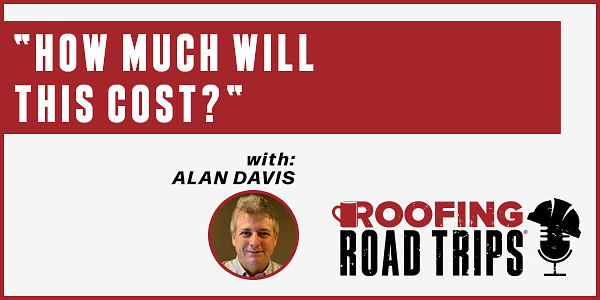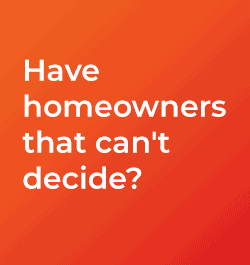How much will this cost? - PODCAST TRANSCRIPT
August 16, 2024 at 11:00 a.m.Editor's note: The following is the transcript of a live interview with Alan Davis of Ingage. You can read the interview below or listen to the podcast.
Intro: Welcome to Roofing Road Trips, the podcast that takes you on a thrilling journey across the world of roofing. From fascinating interviews with roofing experts to on-the-road adventures, we'll uncover the stories, innovations and challenges that shape the rooftops over our heads. So fasten your seat belts and join us as we embark on this exciting Roofing Road Trip.
Heidi Ellsworth: Hello, and welcome to another Roofing Road Trips from RoofersCoffeeShop. My name is Heidi Ellsworth. And today, we're going to be talking about one of the most important things there is and that's the customer journey. Really, how do we make it easy for them to understand price, to understand value? So we got with our friends at Ingage, and specifically Alan Davis, to have this fun and important conversation for all salespeople out there. Alan, welcome.
Alan Davis: Hey, Heidi, thank you so much for having us on again. I know we've had our CEO, Dean, join you a few times, as well as our marketing folks as well have been on, Pam and whatnot. So as the product manager here at Ingage, I'm excited to be part of the podcast network and providing a bit more information for all of our customers in the industry about how we can really improve the selling process into the home improvement space.
Heidi Ellsworth: I love it. I love it. I have had so much fun with everyone from Ingage, and I just love how we keep bringing all this great information. For that sales experience, that customer journey, I think, is so important. So you know what, Alan? Let's start out with an introduction. So if you could introduce yourself and tell us a little bit about what you do in product management with Ingage.
Alan Davis: Absolutely. So, again, Alan Davis, the product manager here at Ingage. And prior to joining Ingage about two years ago, I've held roles as a software developer, sales engineer, engineering manager, business development, product and project management, ranging from small startups to large enterprises like Motorola and Ericsson.
My passion is really about connecting problems and solutions. When I was an engineer, I'd be the guy always asking, "Why am I doing this? What problem am I solving?" And so, what happens in business as you start moving up the chain, when you start asking more questions? And pretty soon, I was managing projects and I was talking to customers and that really led me in in discovering this passion about connecting the problems and the solutions, where if the solution doesn't exist or the current solutions aren't meeting expectations, let's go build it. Let's go make it better. Let's improve things. Right? And that's really what I love seeing.
I learned early on that I wasn't a great developer in the sense that I couldn't make money at it. Let's draw an analogy with our home improvement folks out there. I use the term plumber, right? I'm a do-it-yourselfer guy. I live in the coast of Maine here. We love doing things ourselves up here. I can plumb. I can sweat pipes. I couldn't do it to make money to save my life. Right?
So the same idea here is that I can create, I can build things and software development is my medium and I really love solving problems through software. And my 30-plus-year experience, as I mentioned, has spanned a lot of different kind of industries, from expense management to computer security and management and lots of other things as well.
And I'm really excited for the opportunity we have here with Ingage. I'm bringing a lot of experience from my history into this industry, which I saw being really underserved by technology. And I'm so excited, as I've been talking to our development partners, our industry partners, our customers, that there's an awareness there as well and they're thirsting for help in folks like us to come into the industry to really help solve the problems I was solving 10, 15 years ago for other industries. Right?
So here we are. We've got a wealth of knowledge at Ingage, and I think really in the home improvement space to really help bring a lot more mature and integrated solutions to the market, to really help solve those kinds of problems out there and make things better.
Heidi Ellsworth: I love that. I love it. And I just love listening to you talking about product management with software and technology bringing it in, because I was part of the EagleView startup and launch and that was one of the funnest things to sit and listen to product managers and developers and really learn from that. There's so much that roofing needs right now.
And I think when you're looking at it, how we are presenting that to the homeowners and their decisions and how they make decisions and the respect of roofing and all of that. You have Ingage, and with you, Alan, really looking at that, like you said, bringing it to the industry. Talk to us a little bit about what you're seeing with homeowners and building owners, but homeowners, in their decision-making processes.
Alan Davis: Yeah. Yeah. I was thinking about it as I was prepping this. One of the things I thought I would answer is a question that maybe some of your audience has, is, what is a product manager and what do they do? And that leads really into kind of your question here as well. So product managers are bridging the gap between the business and the technology. Right?
We are here to help the business understand how to use the technology, build solutions that really solve the problems that we're setting out to do. We do this by taking input from all kinds of sources. Right? I talk to our internal team, our marketing folks, sales, support, development, our leadership teams, to understand what we need as a business to grow. We talk to industry experts, partners. Most important of all, I talk to our customers and those who want to be customers with Ingage and that's where I learn all the insights and things like that.
So I want a big shout-out for everyone out there that if you're not talking to your product manager for any product you have out there, get ahold of them. We want to talk to you. You have the answers to the test. And you know what? You're frustrated and I'm frustrated, because we can't have a conversation to solve your problem. So, Heidi, that's really what my passion is. As you can hear, I'm excited about it. If I'm not talking to customers, if I'm not figuring out what's ticking and what's not ticking, then we're not doing our jobs as product managers out there.
Heidi Ellsworth: So I just love that, because being my background of marketing, sales and marketing, that was always my favorite thing, was to be able to have contractor-driven conversations. Where's the pain? What's happening? And really, there is pain, I think, sometimes in that really understanding how to present... And, Alan, when you really think about it, everything is changing and they say it's the millennials or the Gen Zs, but I think it's as much the Gen Xers and the boomers, because we're learning from our kids.
And so, that sales process, it's not just two people sitting at the kitchen table every time. Right? We all have lives. We're all busy. We're running. So salespeople have to be really empathic, maybe is the word, I know that's a little strong, but yeah, in understanding the needs of that consumer. From a product management side, how do you kind of have that engagement with the salespeople and then learning about that, the homeowners and really what they need for their decision-making process?
Alan Davis: Yeah. It's no different than what you just said about what we need the reps in the field to be doing, that empathy, that listening. I'm first and foremost a good listener. Right? My wife probably tells me sometimes that I don't talk enough because I'm just listening most of the time, because that's what I want to hear. I want to hear what's going on.
And I use a technique called the five whys. You're never going to get a straight answer. It's going to be why this, why this, why that? And it's really about exposing and uncovering things. So in those journeys and things, we've really seen a lot in the market where there's a fair amount of just lack of real understanding in how to use technology, how to apply technology, how to use a tool. In the home improvement space, roofing especially, you buy tools. You use tools all day long. You invest in tools, but they're physical things. You understand how they work.
We need to help the industry understand that the software is nothing more than a tool, and you need to have the right tool for the job and apply that tool appropriately. And part of that is understanding what are your needs. You mentioned the sales process. I like to elevate that up to a selling system, where we've even matured away from a sales process to something that's much more of an ecosystem of tools, technologies that fit together to create a system of selling that's driven from ideally a methodology that we're following to help keep everything in line and structured so that those sales processes, those things that we do and execute on, fit into the system and the methodology.
Heidi Ellsworth: Yeah. That's so true. And really, when you're looking at that, being able to listen and then pull exactly what you need at that moment to help that homeowner through the process of understanding the value, making good decisions and all of that. And you also said in there, and this is so true, that one of our challenges is just the industry not really understanding the use of technology. And really, I mean, Alan, let me be honest. I used to create flip-books back in the day. Flip-books.
Alan Davis: Yeah, right. I was a PowerPoint guy, I'll admit it.
Heidi Ellsworth: Yeah.
Alan Davis: I learned my mistakes. I learned what good software and good presentation software is like. Right?
Heidi Ellsworth: So we're all catching up, and we're all making that happen. So what are you seeing as common challenges for those sales reps out there? Because, I mean, it seems to me that it's a little bit generational, because I really believe that young people coming in, who are going into sales, love the technology. But it may be also harder for people who have done it for a long time.
Alan Davis: Yeah. The funny thing, it really comes down to a lot of the sales training and looking at the folks out there. I use an analogy called The Wizard of Oz. Right? Not everybody needs the same things. And a side note, I do some coaching and I look at all the kids that I'm coaching and each one of them needs a little something different. And I specifically ask them, "What do you need?" or I'll tell them, "This is what I think you need."
The idea is that no one tool, no one system is probably going to solve everyone's needs. So if I'm a more mature person, and I might be the top seller and maybe I've never used a presentation, but what I want to do is take that top seller, have them understand how to use the presentation, because he's doing all the things already. Right? We need to bring that knowledge into the system, the selling system, in the form of coaching tools, techniques that they're using and then allow that to proliferate through the rest of your sales organization. Right?
So as far as what I'm seeing really with the gaps sometimes, it is what sometimes I call application fatigue, especially for folks that are just used to simple systems of flip-books, having physical samples and some of those kinds of things, where now I'm relying on technology to represent some of those things. And one of the things that we can really do well is really create that platform to create, share and measure all of that different technology out there.
So one of the most important things we do is not just about creating a presentation, but it's understanding how we can share it effectively so everyone's on the same page, i.e., the millennial that's go hung and wants to show everything and say everything to the professional who knows that you just can't show everything. You don't need to be showing it. 50, 30 pages doesn't really matter. It's about driving the value and understanding the connection you have with the customer to get them the information they need to make what I would consider an intelligent decision and an informed decision, using the information you're providing them and building that rapport.
Again, our platform is a tool to make that connection and being able to be that transparency and represent yourself and your products in an effective, professional way. And like I mentioned, Ingage as a platform is really there to really help with that selling system, being that presentation layer in your selling system to really be able to create, share and measure the effectiveness of how you're presenting information in the field.
Heidi Ellsworth: I have to pick up on one comment you just made earlier that I think is really... that we have this wealth of knowledge in older salespeople, who have been very successful doing it their own way. But from a company standpoint, being able to share that knowledge, coach that team, share the analytics, show how they're presenting everything, you're right. That is so invaluable. And with what Ingage does, showing the analytics, you can really see, "Okay. Our top closers are doing this. This is what's working."
It kind of changes, because I think... And probably still is today, but it used to be there was a lot of competition. And so, salespeople would just hold everything close and, "I don't want to give away my secrets, because I want everything." And that's really kind of changing in today's atmosphere. It's more about the company and everybody rising together. What are you seeing that way when you kind of put what you said there with the analytics that you provide, and what are you seeing with salespeople and companies around that?
Alan Davis: There is a resistance, and I think, like you said, it's really breaking down some of those barriers. We're not here to compete against each other. We're here to compete against the competitors. Right? And so, first of all, you need to define, "Who am I competing against, and why am I competing this way?" Yeah. I want to be the top salesperson in the organization, but I want the organization to grow and blossom as a whole as well. So how I can contribute to bettering that sales process as well.
It's a mindset you're getting into and thinking about how I want to share that. It goes a lot into the DNA and the makeup of your sales team. That's something I've experienced with all kinds of organizations. Back at Ericsson, we were 30-, 40-person sales teams going into large organizations. Boy, you need to be on the same page across the board there, making sure we're all on the same stories and whatnot. But the idea is we were able to really leverage from everyone else's experiences to really create the best opportunity for our customers by using all that wealth of information from those experienced folks.
Heidi Ellsworth: Yeah. Yeah. That is good. Okay. So you have put together... There is a new program, new offering from Ingage, and that is the PriceKit. Can you tell us about that?
Alan Davis: I'm super excited about this, and this is a great example of project management working at its best. It was certainly evident to me in the industry, saying, "Hey, we're presenting price along with using Ingage to discuss the company, discuss the products and really present who we are and what we do." But it kind of stopped at that point and what I was hearing from our customers is, "Boy, I really love to have the rep be able to focus on," to your point earlier, "about the interaction with a customer, listening, empathizing, not trying to work a spreadsheet or get a napkin and scribble some things down."
It was slowing the process down, and it was creating a disjointed experience for that customer. Right? They weren't seeing a nice, clear, cohesive... You start off wonderful, and then all of a sudden, you fall off the table with a napkin or a spreadsheet. And I really think, as I heard customers talking about that, that was one of the major things, is, how can we professionally present a number to a customer?
And as I went through the discovery process, they talked about... And we talked to everybody. So in this particular case, we were talking to 30, 40 different customers. We put some prototypes in place, had customers using these prototypes out in the field to understand how to best interact with things and how to build a solution that could really meet different needs.
And what we found is no one did it the same way, and there was a tremendous amount of flexibility needed in how people did it. So the first process we had to go through was understanding what's the need, and we present price. Okay. It's a number. Well, how do people present price and how do they present number?
Well, there was no one way to do it. So PriceKit evolved over time by really understanding all the different nuances in presenting price. But most importantly, how do we fit price into and this is a term near and dear to my heart, into your price conditioning process? Right?
It's not about showing up with a number. It's about taking a customer through that journey with the experience conditioning when you first knock on that door, and presenting yourself as a professional, to talking about, "What's the value conversation we're having?" It's not about cost. It's not about price. It really is about value, and really understanding how to incorporate those kinds of things.
So when you get to the point of having to talk about a number, not only is that nicely blended into the conversation you just had and it seems like it's just a continuing conversation, you also got the customer in a situation where you kind of know the answer to the test. You know what's important to them. You've conditioned about maybe market values and cost versus value, numbers and things like that, leading up to the point where now you've got a wonderful tool to really help the customer understand their path to affordability. Right?
And it's really about that. It's providing options and things like that to customers, and really have them be part of the process and bringing them in. Again, near and dear to my heart. As a product manager, I need to run processes and things here. So a lot of analogies between product management and what we do and what folks are doing in the field selling, where I've got a process I want people to follow, but I can't be the one to dictate that process. Right?
We need people to take ownership of that and be part of that. And when they're incorporating that with their customers, the customer is now part of that conversation and really providing the feedback necessary. So the tool, PriceKit, is there just to be a mechanism for the sales rep to really describe and show value, just like they would describe and show the value of a product.
These are the benefits. This is the good, better, best options you have based upon different criteria or the warranties or our manufacturing or our installation processes and everything that goes around that. We're doing the same thing with a number, and being able to help people understand that in a really effective way. It's just presenting a piece of information. It's clear, concise and consistent.
Heidi Ellsworth: And I think that, right there, that is so important, is the consistency and the journey for that. I kind of started this out, with that customer journey, making it so, "Yeah, this makes sense. I get it, and there's no surprises," as you put that. So what's some of the feedback you're hearing from some of your contractors out there who have been using this?
Alan Davis: Yeah. So it's been fantastic. Right? The biggest thing is that they're able to drive the consistency. They feel like they know they've got some controls out there, that people aren't scribbling on the back of a napkin, that there is a process that they're going through. And most importantly, like I said, we're incorporating price conditioning, not just a number and a tool.
So what PriceKit's all about is really being able to provide those sales managers the ability to create different offers and different workflows for that customer journey that aligns with their methodology, whether you're value selling, solution selling, using some of the various different other methods that people have been representing in the industry. You can align the tool with your needs. So first and foremost, it's not a design tool. It's not something you have to go in and spend a lot of time and effort on.
You already know the information as a sales manager. You know how you're entering price. Is it a project total, or is it like installation and product together that create the price? Because maybe you offer different discounts in different kinds of things. Maybe you offer financing in different kinds of ways. So the idea is we incorporate all this information and then allow you to configure a tool that aligns with your needs, but most importantly, also keeping the reps in line with where you need them to be.
For example, do we want the rep to understand where they are against their commission? Absolutely. Right? We want to make sure they aren't overselling, so we want to make sure that they can't just enter a number that exceeds what I think they would do or maybe I want to allow some flexibility. And for that more mature rep, I know that they can be there, but I want them to know they're going to eat a little of their commission if they're going to cut that deal by another 3% or something like that.
So it's all about the information for the rep and for the customer to really consume... Is this the best opportunity for both sides? Sales is a partnership, right? We're going in and we're building a relationship first and foremost. I'm going to provide a service or a product, and you're going to purchase that product, but most importantly, you're going to use that product and enjoy the product and we're going to create a relationship from that.
And this is just one level to make sure that you ensure and put a good stamp on that conclusion of that conversation around, "Yeah. I feel good about the value I'm getting out of this conversation," and not just, "I feel good about the price." Right?
Heidi Ellsworth: Well, and I love that, because a big part of it too is, you will have salespeople who will go off a little bit on a tangent on their own. But they also may be like, "I didn't know. I don't know." Now it's clear. It's there. And as the sales manager sets it up, everybody is on the same page. Everybody knows what they're selling.
Alan Davis: And it really drives into that whole share pillar that we stand on from Ingage. What happens when the monthly promo changes from 10% to 7% or we're going to introduce a new fall savings option or we just got a new program for veterans discounts or something like that? All these things can change on the fly. It's really as simple as a sales rep going in, a quick change of the tool. The new changes are pushed out along with the presentation, like we always do. So everyone gets the updated information, and they're off and running and it's really an elegant way for sales folks to really maintain that control.
Heidi Ellsworth: Yeah. Yeah. I love it. Okay. You talked about the sales manager going in and setting this up. How hard is it, and how does it work?
Alan Davis: What we're doing in Ingage is we're really trying to... And we talk about this. We're passionate about creating high-value and elegant presentations. And for me, expecting someone to come in and build a tool like this is a nonstarter. In talking to folks, they wanted a way to configure, not to build. So Ingage Marketplace is our marketplace for all of our content from Ingage, from third-party developers, as well as manufacturers.
This is where some of the roofing manufacturers are representing all their products up there. Owens Corning, I know we've talked about from time to time, CertainTeed, some of those are there. But it's really the platform where I can start building things. So PriceKit is just a kit. It's a tool I'm going to bring into my presentation. It's just a page that gets dropped in, like everything else. So if you're familiar with editing in Ingage, it's pretty straightforward. It's just going to click, click kind of a thing and then you're presented with a series of configuration screens.
So it really is about configuring something, and then the result is this elegant view of your selling process and how you want to represent price and value to your customers. So it really starts with me understanding my sales methodology and how I want to sell, because the tool is there to adapt to you. I don't expect you to adapt to the tool.
And there's something I'm a little fearful of that I want everyone on the podcast to know. It's not just dropping in a tool and putting a number in front of the customers and expecting some magic bullet. There are some great webinars we'll talk about a little bit we've done around that price conditioning, how to really build the value through your selling process and things like that.
This is just a component of that process, and I want to really stress that to folks. But you already know these answers anyway. You know what kind of financing you provide. You know what kind of discounts you want to provide. You know the process you want take a customer through. Maybe you start with that market value, just to put a number in front of them that says, "This is what an industry average looks like. Okay. Great. Now let me show you what we can do, what your job looks like, and then let's talk about some paths to affordability."
Maybe you want to "no, no" for the first year. Maybe that's important, because your cash flow is a challenge or maybe you're looking for a specific lengthy payment. The tool can adapt and really adjust to what your needs are and how you want to represent things, like if it's a monthly payment or it's just a big number. For example, we could hide the big number altogether. Maybe it really is focusing on a monthly number to people, because that can be scary.
What you're hearing is a tremendous amount of flexibility built into the tool, as I mentioned earlier and we talked to people all over the country. Even different regions have different philosophies, different approaches to doing things. Some areas are heavily in financing, because they're very comfortable with those kinds of things. Other areas are cash-only or pay now, pay later. There's all kinds of things out there.
So really, it was a tremendous amount of input from the customer base out there that drove a lot of this configuration that really said, "I need the tool to adapt to me. I don't need a tool to do what you want me to do." And so, it's been really good. So you start with that methodology, basically putting the information you know and then you think about how you want to represent this. And then most importantly, how do you want to put those guardrails on the reps out there? Because there is some flexibility.
Like I said, you may trust particular reps to be able to enter in a particular percentage of a discount. Maybe they can play with it. Maybe it's just naming the discount something that's effective. It doesn't really matter what the discount is. We can offer up to 5, 10%. I can call it military. I can call it teachers appreciation. But again, going back to our conversation earlier, how do I align and empathize with that person across the table? What's going to be important to them?
Yeah. Just saying, "Here's 5% off, Heidi." Oh, okay, whatever. What do I say? "Oh, boy. As an industry professional, Heidi,\ and as a teacher, we really appreciate your efforts. We really have a nice opportunity to give you another additional 5% off the product." Right? That's a more compelling conversation than just throwing numbers at people. So it's about adapting it, really making it personal as well and that's really important.
And the last thing, like I mentioned, is really then training the reps, having them really understand how to effectively use the tool. And that really goes for the mature salesperson, as well as the millennial coming in and everyone in between. You really need to be effective with the tools in the process you're in. It's very important to make sure that you're not, again, just using the Ingage PriceKit as a replacement for the napkin. Right? We're ensuring the process here. We're giving you a tool. We're showing how effective it can be, and we really want you to see the results by using the tool.
Heidi Ellsworth: And I love how you say tool, because that's what it is. I mean, any tool that you have in sales is nothing if you aren't trained in how to sell and how to listen and how to do all of those types of things. And so, I think sometimes technology people think, "Well, it's going to take over." Like you said, it's the whole solution and everything's going to be perfect and I'll close every time. No. Whether it's technology or anything else, it's a tool to use to make that process better, to make that journey and to be more successful, but you have to put the time into and I love that you keep saying that.
Alan Davis: Yeah. I qualify that one way. It's to make your process more effective. Your process, right? Because we talk about sales process, and a lot of people want to be this, but I don't think they really understand, is that, again, these methodologies, these tools are there for you to then incorporate into your selling system and process, a lot of taking-the-best-of-both-worlds kind of a thing and building your own system.
Heidi Ellsworth: Yeah. Yeah. That's great. So you and Ingage overall, you put a lot of things out there to help train and for the training and how to use the technology as a tool. Let's talk a little bit about that, about some of your video series, your case studies, your webinars that you mentioned. How can contractors use those to help in the training of their sales teams?
Alan Davis: Yeah. So something we've done with PriceKit, and you're going to see this as we continue to roll out more capabilities at Ingage, is we've really focused in on some video and video training and video awareness. So with PriceKit, we've launched a whole video series. Number one, we've had some industry professionals obviously help us as well. We had Kyle Sellers. I don't know if you know of Kyle. He's a sales coach and sales trainer, come in and actually use the tool in some mock settings for us and we had nice video shoots.
So if you just want to see how this looks, you want to see how a professional can use the tool, here's Kyle showing you a couple of representations. Some great videos to show you what it looks like in the field. I think that's been critically missing when people want to make connections with buying software, "So what? So I see some things on a screen. So someone is telling me it's going to do these things. Show me what it looks like. Show me how that process can be matured." Right? So that's important. Right?
I wanted people to understand... I want to see them sitting in that role that Kyle is sitting in, talking to a customer, feeling engaged, feeling happy, feeling confident in what they're delivering. So that's first and foremost, is the day in the life. There's a whole series of just informational videos just about how to get started. A lot of conversations we're having here up there, as well as the nuts and bolts, the how-to.
We've got a fantastic training manager, Rocky, who's got a little series called Rocky's Corner. So we'll continue to offer a lot of more of the how-tos, the mechanics, the nuts and bolts of doing some of these kinds of things as we do that as well. On the other side, as you're well aware, Pam and our marketing team does a tremendous job of our webinar series and that there's two specifically about this topic I want to point out.
Now, you can go to ingage.io and go to our blog in our Resources section and the first one is The Price Is Right: 5 Keys to Presenting Price With Power, and this was with Tim Musch from Paradigm Vendo and Justin Hatcher from 1 & Fund. And they did a great job of talking about all the challenges that we discussed here briefly and really talked about some actions you can take to incorporate the price conditioning and pricing conversation in your systems. Pretty cool. So anyway, so ingage.io and the Resources section. You can find all that information.
The other thing I want to promote, obviously, is call us. Sign up for a demo. We'd love to show you this. Right? We've got a sales team. Even existing customers reach out to our... Your support folks, and we're happy to jump on a call and talk about how this fits in. And during the first releases, I love to be on these calls as well. I'm such a first impression kind of a person. So as we release this out, I love being on these calls and jumping in with folks and hearing what customers have to say. So you might hear me on the call as well if you jump in, or maybe I'll do the demo.
Heidi Ellsworth: I love it. I love it. That is excellent. But that's what it's all about, listening and bringing back all the ideas, the feedback. That's the thing that's amazing about technology. It only can get better as we continue to get feedback and work through it. I mean, we see that at RoofersCoffeeShop all the time. Right? "Oh, okay. We need to tweak that a little bit. We need to do this a little bit." What? It's technology. We can do that. That is something that makes everything just a little bit faster.
Alan Davis: The one line I may leave you with from the product management world that I subscribe to is, make it work, then make it better. It's all about iteration. Don't get an analysis paralysis. Now, I understand, rolling something out to the field, you need to be a bit more ready to go. But continue to evolve that process. Right? Don't get stuck in a rut.
When I came on board with Ingage a couple of years ago, I was looking at the rate of change of the presentations and I was appalled at how few changes are made. They thought, "It was just a flip-book. I don't need to change it anymore." No. No. And we're working on some really cool...
We're going to have some more conversations, Heidi, in the future about what we can do even beyond this and making these presentations more dynamic and more interesting and, most importantly, more compelling to customers by creating content that's aligned with them, their demographic, their needs and things like that. So there's more coming from Ingage. Looking forward to more conversations.
Heidi Ellsworth: I have to tell you, to me, that is so exciting, because really, when you look at it, this is how we are every day on RoofersCoffeeShop. Make it work, then make it better. I'm going to write that down. That is excellent.
Alan Davis: Yeah.
Heidi Ellsworth: And I can't wait to talk about more, because I say this all the time. It's a living, breathing thing. Right? Don't let it just sit there and be stale.
Alan Davis: Yeah.
Heidi Ellsworth: Keep it active. Keep people in tune. And so, doing that with your presentations only makes sense, because there is not a single roofing company that just sits still.
Alan Davis: Yeah. Yeah.
Heidi Ellsworth: They're evolving, and they need to show that to their customers.
Alan Davis: Yeah. And that really is the philosophy, right? And it really is the philosophy, to wrap it up, of PriceKit here. Right? The idea is that that's a tool you can configure and grow over time. So, for example, I don't offer finance today. Fine, don't use it. Present your offers in a way that makes sense to you. When maybe you decide that finance is something that is important to you and it's an opportunity for your customers, well, you can build and add that in.
So, again, we're here to grow with you and that's really important for me as a product manager to understand the guys that are just getting started, to those that are the multibillion-dollar, potentially, industry leaders out there. We like to fit in between, and everything in between and really adapt as needed.
Heidi Ellsworth: Really help the industry be even more professional. So thank you for doing that. That's awesome. I love it. And I have to tell you, all of this information, everyone, along with ingage.io, you can find it on RoofersCoffeeShop in the directory. So check out those videos, the series, everything that's going on. We have links. You can get there very easily by just hitting the Ingage directory. So, Alan, thank you so much for being here today. This is just one of my favorite topics. You guys are always so fun.
Alan Davis: I appreciate it. I appreciate this series. I've listened to all of them. It's great. I learned a lot. This is where I get information, Heidi. Right? So thank you, thank you, thank you for being my resource to help understand what's going on in the industry as well. This is a real good partnership.
Heidi Ellsworth: You made my day. I love it. Thank you.
Alan Davis: Wonderful.
Heidi Ellsworth: Well, we'll have you back. So let's look at that soon, because I want to hear about... I know lots will be coming out into 2025.
Alan Davis: Absolutely.
Heidi Ellsworth: So this is really exciting. Thank you again, and thank you all for listening today. This is the kind of information that can help grow your business. Be sure to share it within your business and share it within our industry so that we all are continually bringing roofing respect across the board.
Be sure to check out all of our podcasts under the Read Listen Watch navigation of rooferscoffeeshop.com and on your favorite podcast channel. Be sure to subscribe and set those notifications so you don't miss a single episode. We'll be seeing you next time on Roofing Road Trips.
Outro: If you've enjoyed the ride, don't forget to hit that subscribe button and join us on every roofing adventure. Make sure to visit rooferscoffeeshop.com to learn more. Thanks for tuning in, and we'll catch you on the next Roofing Road Trip.
Recommended For You

Steffney Jones - Retooling Your Revenue: The Power of Customer Communication for Service Businesses - PODCAST TRANSCRIPTION
Read More ...
Donavan Morgan: The Roof Gallery Summit: Black History Month Event - PODCAST TRANSCRIPT
Read More ...
Lorna Rojas - Elevando el Bienestar en la Industria - Transcripción del Podcast
Read More ...


















Comments
Leave a Reply
Have an account? Login to leave a comment!
Sign In